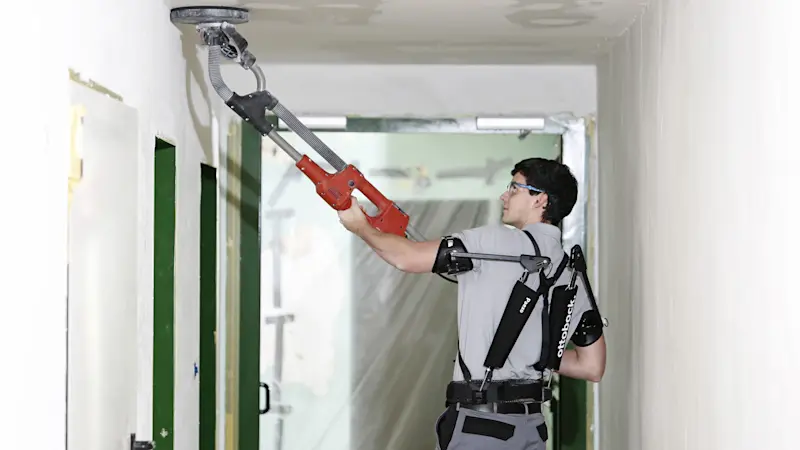Exoskeletons – the revolution for the building trade
Ottobock’s Paexo makes overhead work comfortable

Monday, 14 January 2019
The building industry is facing increasing challenges due to a lack of skilled specialists and an aging workforce. Overhead work in particular is very stressful for workers in many trades, for example those who work in drywall construction or install electrical, plumbing or heating systems. This results in a need for innovative devices that help people protect their health over the long term as they carry out their demanding everyday working routines. Ottobock has responded to this need by developing the Paexo exoskeleton.
“The Paexo is a passive exoskeleton that does not need an energy supply. This makes it especially lightweight – at 1.9 kilograms, it’s actually the lightest exoskeleton of its kind,” states Dr Sönke Rössing, who heads up Ottobock Industrials. Workers wear Paexo close to their body, similar to a backpack. The arm shells transfer the weight of the raised arms to the hips using mechanical cable pull technology. This provides noticeable relief to the shoulder muscles and joints, and overhead activities can be performed much more comfortably. The design is based on natural human movements. Users can walk, sit and also pick up objects with the exoskeleton. It can be put on and taken off in less than 20 seconds and can be comfortably worn for more than eight hours.
Paexo relieves the musculoskeletal system
“Exoskeletons have the potential to revolutionise the building trade,” says Rössing. “The Paexo significantly reduces critical physical strain during work. This type of preventive relief can reduce work-related musculoskeletal diseases in the shoulders.” These disorders are the most common cause for inability to work in Germany and Europe, and therefore a significant cost factor for companies and healthcare systems.[i] In 2017, around 27% of sick days in the building industry were attributed to musculoskeletal diseases. These figures are even higher for jobs that typically include a large share of overhead and above-shoulder work: building and drywall construction (33.2%), electrical installation (29.7%) and structural engineering (29.4%).[ii]
But the exoskeleton doesn’t just offer health benefits for workers. “We’ve received many reports that using Paexo has a positive effect on the quality of the work itself,” adds Rössing. “Inaccuracies during overhead work are reduced, because the arms and shoulders are less tired. This makes it possible to achieve the highest possible quality, for example when soldering seams in industrial piping systems.”
The building trade tests Paexo
Industrial installation company Thor tested Paexo at its building sites in November 2018. The robust exoskeleton was used in different trades, for example during the installation of heating, electrical and plumbing systems. “Our employees were delighted by the way it immediately relieved their muscles, for example during overhead welding or laying wiring under ceilings,” reported CEO Kersten Thor, who oversees the company’s 1,100 employees and five sites. “My view is that exoskeletons also make jobs in industrial installation more attractive. They can increase employee loyalty and help us recruit new employees. We are currently planning to use the Paexo more widely at our building sites.”
Development with expertise
The fact that the Paexo can be used in very different sectors, for example at aviation and automotive companies, in the food industry, at shipyards and building sites, demonstrates the potential the exoskeleton offers. Since 2012, Ottobock has been researching innovative solutions to make jobs in building trade sectors, industry and logistics more ergonomic. To this end, the med-tech company founded its Ottobock Industrials business unit at the beginning of 2018. The team draws on the company’s nearly 100 years of expertise in biomechanics and orthopaedics in the development of new products. “In addition, we have an in-depth understanding of the crafts sector’s requirements, because Ottobock has been deeply rooted in the orthopaedic trade since its establishment,” stresses Rössing. “Our O&P professionals now use the Paexo as well, for example when milling plaster models at shoulder height.”
The Paexo is the first of many products to be launched by Ottobock Industrials. The exoskeleton has been on the market since October 2018 and costs around EUR 4,900 (leasing is available).
[i]BAuA (Federal Institute for Occupational Safety and Health) (ed.): Sicherheit und Gesundheit bei der Arbeit - Berichtsjahr 2016. [Safety and Health at Work - 2016]. (see Link)
[ii]Scientific Institute of the AOK (WIdO), University of Bielefeld, Beuth University for Technology Berlin (Badura/Ducki/Schröder/Klose/Meyer) (ed.): Absence Report 2018, Tab. 29.3.14. (see Link)
Downloads
Image 1 - Sanding ceilings the easy way
Image 2 - Overhead work on building sites
Image 3 - Exoskeleton for the building trade
Image 4 - Using an exoskeleton
4 results out of 5

